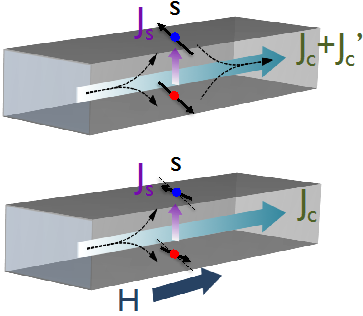Modulation of the resistance of thin metals using the Hanle effect
A new vista in spintronics was opened in 2004 with the observation of the spin Hall effect in GeAs at 20 K by David Awschlom and his group. In the spin Hall effect the electrons of a charge current flow in a nonmagnetic conducting material in the absence of an external magnetic field. An applied external electric field separates the electrons perpendicular to the conventional current direction into spin-up and spin-down populations that accumulate on opposite sides of the conducting material. The same phenomenon was detected at 295 K (room temperature) in ZnSe in 2006 by the same researchers.
The spin Hall effect is due to spin-orbit coupling (see How to induce a giant spin-orbit effect in graphene and Impurities and spin Hall effects in graphene for detailed explanations) and this coupling can be intrinsic or extrinsic to the material: The intrinsic mechanism is a consequence of the band structure of the material, whereas the extrinsic mechanism stems from scattering of the charge carriers by impurities that locally induce spin-orbit coupling (see The spin texture of surfaces and electron scattering).
One of the possible and recently discovered (2013) consequences of the spin Hall effect for certain materials is magnetoresistance. This spin Hall magnetoresistance was found in nonmagnetic metal/ferromagnetic insulator bilayers.
Magnetoresistance is an increase in the resistance of a material due to the presence of a magnetic field, which alters the path of the electrons. At normal temperatures the change in resistance resulting from the magnetic field is small but at very low temperatures the increase is considerable.

Now a team of researchers from CIC-nanoGUNE, CFM-CSIC and DIPC (some of them linked to Ikerbasque) report in a letter 1 published in Physical Review Letters they have found a novel magnetoresistance effect occurring in non-magnetic thin films with strong spin-orbit coupling. The magnetoresistance measurements are consistent with an effect originally predicted by Mikhail (Michel) Dyakonov in 2007.
The spin accumulation created at the edges of the thin metal films of Pt and β–Ta by the spin hall effect—in the geometry used by the researchers, the top and bottom surfaces—is suppressed in a magnetic field (H in the figure) due to the Hanle effect (spin dephasing arising from simultaneous precession and diffusion).
The researchers found that the resistance of these films can be modulated by a magnetic field due to the suppression of the spin accumulation created by the spin Hall effect via the Hanle effect.
This novel phenomenon provides a simple alternative way to quantify spin transport parameters such as the electronic diffusion coefficient, the spin Hall angle, or the spin diffusion length in ultrathin metal films with strong spin-orbit coupling without the need to involve ferromagnetic interfaces.
Author: César Tomé López is a science writer and the editor of Mapping Ignorance
References
- Saül Vélez, Vitaly N. Golovach, Amilcar Bedoya-Pinto, Miren Isasa, Edurne Sagasta, Mikel Abadia, Celia Rogero, Luis E. Hueso, F. Sebastian Bergeret, and Fèlix Casanova (2016)Hanle Magnetoresistance in Thin Metal Films with Strong Spin-Orbit Coupling Physical Review Letters DOI: 10.1103/PhysRevLett.116.016603 ↩